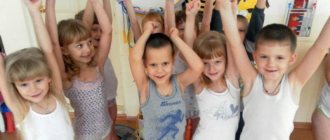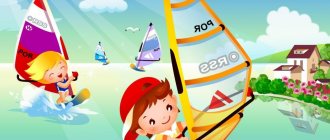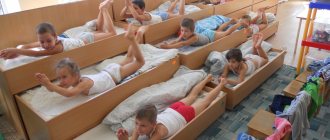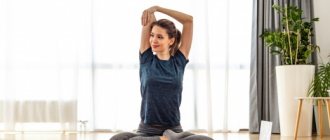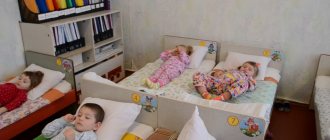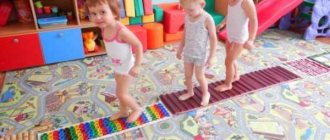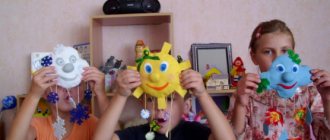Types of gymnastics after naps in kindergarten
Warm-up in bed and hardening
Without rising from their beds and throwing back the blankets, children perform a small number of general developmental exercises while lying on their backs. Then the group stands barefoot on massage mats located next to the beds . They walk in place for a few minutes, which can be switched to running.
The gymnastics are continued in another room, pre-cooled to a temperature of 19°C. Here, to rhythmic music, children are asked to perform voluntary movements, which end with breathing exercises.
Game activities
Imaginative gymnastics involves children imitating the movements of animals (a frog jumps, a cat arches) or birds (a heron on one leg), imitation of the characteristic movements of athletes (skiing, skating), etc.
Gymnastics after sleep in the preparatory group on exercise machines
The complex begins with a light warm-up: steps, jogging and jumping. Then the group of children is divided into subgroups of several people. The first team practices in the sports corner , where ropes, ladders and other elements are located.
The second team exercises with children's exercise equipment: dumbbells, discs . The third group heads to treadmills and cycling. Classes change every 5 minutes.
Classes on massage paths
It is recommended to carry out such exercises at least 2 times every 7 days. The group practices barefoot. Gymnastics begins with steps along the paths, then the rhythm accelerates and easy running begins, the latter lasting no more than 90 seconds.
Next, you need to do several breathing exercises while walking slowly. Next 2-3 min. The children are encouraged to run continuously.
The lesson ends with slow steps along the health paths.
Types (blocks) of gymnastics after naps in kindergarten
Exercises "lying in bed" or "lazy"
This block includes a light warm-up, finger exercises and acupressure.
How to teach a child to swim - lessons in the pool, exercises
Example:
Who woke up here?
Did you take off the blanket and stretch? (children do pull-ups while lying in bed)
Did you sit up straight and smile? (children sit down and smile)
- Guys, it’s good that everyone woke up. All that remains is to wake up our fingers.
Assignment: place your hands in front of you, fingers extended forward, then slowly bring the tips of the fingers of your right and left hands together.
Note! Children try to bring their palms together 2-3 times, then the palms return to their original position.
– Now let’s show the “washing hamster”?
Assignment: children puff out their cheeks and begin to rub them with their hands, then “wash” their paws.
Breathing exercise block
This block includes a light warm-up, finger exercises and acupressure, as well as tasks for the development of the respiratory system, which helps fill cells with oxygen and increase the activity of the central nervous system.
Example:
- Who woke up here?
Did you take off the blanket and stretch? (children stretch while lying in bed)
Did you sit up straight and smile? (children sit down and smile)
- Guys, it’s good that everyone woke up. All that remains is to wake up our fingers.
Assignment: place your hands in front of you, fingers extended forward, then slowly bring the tips of the fingers of your right and left hands together.
Note! Children try to bring their palms together 2-3 times, then the palms return to their original position.
– Now let’s show the “washing hamster”?
Assignment: children puff out their cheeks and begin to rub them with their hands, then “wash their paws.”
Exercise "Snake"
Task: Children take a breath, and as they exhale say “ssss” (5-7 times).
Exercise "Dragon".
Assignment: children close 1 nostril and inhale. Exhalation occurs through the mouth. Then pinch the other nostril and repeat the task (5-7 times).
Resistive load block
This block involves getting out of bed and moving into the play and educational space.
Note! This could be: outdoor games, the use of exercise equipment, an orthopedic track, an obstacle course, etc.
Tasks can be for dexterity, ingenuity, strength and balance, eye gymnastics and water procedures.
Corrective track
Gymnastics goals
Gymnastics in kindergarten has the following goals:
- Calm exit from the resting state and the beginning of the wakefulness phase.
- Elimination of lethargy.
- Bringing the child's nervous system into tone.
- Activation of the functions of various systems in the body (respiratory, cardiovascular, etc.).
- Preparation for intellectual activity.
- Increased physical performance.
- Uplifting mood and improving overall well-being.
- Normalization of the immune system, prevention of diseases.
- Hardening.
Features of gymnastics by month
Gymnastics after sleep in the preparatory group takes approximately 10-15 minutes in duration.
In this short time it is impossible to carry out gymnastics covering all the muscles and systems of the body. For the comprehensive development of children, it is recommended to change the composition of activities after sleep every month. During this period, the guys will master all the exercises of the previous complex and begin to warm up and train new muscle groups. Changing gymnastics keeps children interested in classes throughout the year.
The following is a brief overview of several complexes that can replace each other monthly:
- The first group of exercises begins with running in a cold (19°C) room, followed by preventative exercises for flat feet.
- The next complex includes warming up while lying and sitting in bed, breathing and hardening exercises.
- Next, instead of breathing exercises, the complex includes aerobics accompanied by music.
- The fourth complex begins with a hardening run, followed by exercises to prevent posture.
Why do you need gymnastics after sleep in the preparatory group?
Gymnastics after sleep is a series of exercises that provide a smooth transition between sleep and wakefulness. It is combined with corrective gymnastics, which is aimed at correcting and maintaining posture, preventing flat feet, and maintaining muscle tone.
Charging tasks
- prevention of acute respiratory infections, ARVI;
- health promotion;
- strengthening muscles, ligaments and the musculoskeletal system;
- increased central nervous system activity;
- physical development;
- increased mental activity;
- harmonious awakening;
- correction of musculoskeletal function;
- avoiding whims after a nap.
The preparatory group considers themselves “adults” and has difficulty falling asleep, and gymnastics helps to quickly increase the body’s performance. The child finally awakens and is ready for a walk and physical activity.
Rules for awakening gymnastics
During daytime sleep, it is necessary to ventilate a suitable room for air hardening; the temperature difference with a warm bedroom should be 3-5°C. In summer, hardening gymnastics can be performed outdoors.
The moment of awakening is accompanied by quiet music, the volume and tempo of which increases as the intensity of the exercises increases. Charging begins according to schedule with the children waking up; as they wake up, the rest of the children join the process. It is not allowed to force a child to study.
Gymnastics after sleep in the preparatory group should be without sudden movements
The basic rule of gymnastics in bed: exclude sudden movements , as well as getting out of bed, so as not to cause dizziness and stretch rested muscles. Before starting gymnastics in bed, the pillow is removed from under the head.
During charging, children move to a “cold” room or outside for active walking and running. Here you can conduct classes for correct posture and to prevent flat feet, practice corrective walking and run on massage mats. The group then returns to the warm bedroom for further exercise. The transition can be made several times per lesson.
Gymnastics classes are recommended to be carried out in a playful way , this creates a positive emotional atmosphere among children. The technique of performing exercises based on imitation of animals or other images is easier for children to master; such activities develop motor imagination.
How to properly distribute the load
Gymnastics after sleep in the preparatory group lasts at least a quarter of an hour.
A calm warm-up in bed lasts about 3 minutes; it may contain elements of self-massage and finger exercises. Children spend the same amount of time in a cooled room, moving on the floor or on massage mats.
After active exercises, a breathing complex follows. To avoid nausea and dizziness, breathing exercises begin from 30 seconds to 1 minute, gradually increasing the duration of the cycle to 5-7 minutes.
Features of the organization of awakening gymnastics in the preparatory group
Before carrying out the exercises, it is necessary to awaken all children. The amount of sleep and duration is individual for everyone. You should not do gymnastics when some are ready to get out of bed or have not slept at all, while others continue to sleep soundly. Wake-up occurs with musical accompaniment. Experienced teachers recommend using sounds of nature, sea water or children's songs.
Important! To avoid psychological stress, you should never awaken a child by braking or making a sharp sound.
Rules of organization and distribution of loads for children 6-7 years old
Charging conditions:
- the room is ventilated before going to bed;
- air temperature 18-20 degrees;
- children must wear panties and a T-shirt or pajamas;
- for dynamic gymnastics on the floor or mats, socks are put on your feet.
Rules of the organization:
- the set of exercises corresponds to the classes performed in the first half of the day;
- those who woke up earlier should be given a “lazy” type exercise;
- absence of prolonged tension;
- it is necessary to repeat the instructions for implementation several times;
- You should not force a barely awakened baby to actively work with other children. Perhaps he had a bad dream or is not ready for physical work.
Preparing for gymnastics
Load distribution:
To carry out exercises harmoniously, it is necessary to combine types of gymnastics. For example, 3 exercises in a crib, 1-4 on the floor and completing the exercise with exercises to develop the respiratory system.
For the best results, you can use aids: music, video, obstacle course, orthopedic mats, etc.
Important! Charging duration is no more than 10 minutes.
Card file of exercises for block in bed
Gymnastic exercises in bed:
- Sipping. Lying in bed on their backs, the guys stretch their arms along the body, and then pull them behind their heads and stretch the top of their heads up, while at the same time they pull their heels towards the opposite headboard.
- Snake. Children lie on their backs and roll from one side to the other, with their arms pressed to their body.
- Giant dwarfs. From the same position, the guys bend their knees and then straighten them.
- Bike. Abdominal exercise, it is performed lying face up. With their arms extended at their sides, children “draw” circles in the air with their feet, reminiscent of pedaling a bicycle.
- Nut. From a lying position, face up, with a deep breath, the guys sit down and stretch their hands to the toes of their straight legs. Exhaling air, they lie back on the bed.
- Boat. Children turn over face down, stretch their arms up and bend their back with effort, while the top and bottom of the body should come off the surface of the bed.
- Kitty. Standing like a cat on their knees and straightened arms, the guys arch their backs, simultaneously lowering their faces down, then bend their backs down, raising their faces up.
- Slide. Children sit in bed, straightening their legs in front of them, with their palms resting on the bed behind their backs. Relying on bent legs and palms, the guys raise their hips high, then sit back on the bed.
- Wave. The children kneel down. Extending their arms to one side, they sit on the opposite side next to their heels, then perform the same exercise in a mirror manner.
Active loads
Gymnastics for waking up after a nap for children in the preparatory group includes several sets of active exercises.
Bedside activities:
- Curious kids. Children stand with their hands on their waists and turn their faces in both directions, as well as up and down.
- I'm growing. Pressing their heels to the floor, the guys stretch their clasped hands upward, palms turned toward the ceiling, while at the same time the top of their heads stretches upward.
- Mill. Children twist their straight arms first forward, then back, legs slightly apart.
- Heron. Standing straight on the left leg, hands on the belt, the guys bend their right leg and press the extended toe to the left knee. You should remain in this position for at least 30 seconds.
- Airplane. Children straighten their arms parallel to the floor on the sides, then continuously uttering the sound “oo-oo-oo”, they bend to one side, then to the other. During the exercise, short pauses are made to breathe.
- Hissing geese. The guys stand with their hands on their waists, placing their feet shoulder-width apart. Leaning forward and moving their straight arms back, children imitate the hissing of geese.
- Ball. The guys jump on both legs in one place.
Active exercises for a cool room:
- Children walk in a circle, alternating very small steps with wide steps. Next, they rise on their toes, straighten their arms up and walk like a heron, with their knees raised high. This is followed by a light run, ending with a squat. In conclusion, the children are offered long jumps.
- The cycle begins with steps on the toes with arms raised to the ceiling. Then the children walk in normal steps and periodically, at the teacher’s command, stop on their right or left foot. The movement continues in a squat position, hands on the waist, followed by a cheerful march with high knees.
- The guys actively walk around the room, then rise on their toes and, continuing to walk, straighten their arms up. Then they sit back on their heels, place their hands on their waists and walk on their heels. The cycle ends with a light jog, raising your heels toward your buttocks.
Active activities for a warm room:
- Christmas tree. From a kneeling position, with hands placed at the waist, children straighten their right leg to the side and at the same time extend their arms to the sides. The same exercise is performed for the other leg.
- Sunny mood. The guys perform jumps in one place, raising their knees as high as possible and gradually turning around their axis by 90°. After a full rotation, the children rest, walking around the room, then the exercise is repeated again.
- Fun gymnastics. Children stand straight, legs apart, but not wide, hands placed at the waist. Putting their right leg back with their toes extended, the guys spread their arms to the sides, after which they return to the main stance. The same exercise is performed on the other leg.
- Agile jumpers. The guys perform jumps in one place: first 5 jumps, then 5 big jumps.
Preview:
Card file of gymnastics after sleep
GYMNASTICS AFTER SLEEP (school preparatory group)
1.I.p.: lying on your back, arms extended upward. “Stretches”: press your chin to your chest, socks towards you; stretch your head and arms in one direction, your heels in the opposite direction; relax in i.p. Repeat 2 times.
2.I.p.: lying on your back, arms along the body. Raise your head, raise your toes, stretch your arms forward, hold in this position for 5 counts; return IP, relax. Repeat 4 times.
3.I.p.: lying on your stomach, arms bent in front, head resting with your forehead on the back of your fingers. Raise your head and shoulder girdle, arms in “wings”; stay in this position for 5 counts; return to IP Repeat 5 times
4.I.p.: the same. Raise your legs one by one, without lifting your pelvis from the bed, 5-6 times with each leg.
5.I.p.: lying on your back, arms along the body. Spread your arms to the sides - inhale, cross your arms over your chest - exhale. Repeat 4 times.
6.I.p.: main stand. “Birds are flying”: 1 - raise your arms to the sides, up; 2 - return to IP. Repeat 5-6 times. Perform smoothly, without rushing.
7.I.p.: legs slightly apart, arms bent in front of the chest, hands down. “Bunnies”: low jumps on two legs (8-10 jumps), pause. Repeat again.
8. Breathing exercise “The cow mooes”: on a long exhalation, say “moo-oo-oo”, inhale; repeat several times.
Walking along the path of “health”.
1.I.p.: lying on your back, arms along the body. Press your chin to your chest, pull your socks up; stretch, aiming the top of your head in one direction and your heels in the opposite direction; relax in i.p. Repeat 2 times.
2.I.p.: lying on your back, hands behind your head. Raise your head, point your toes toward you, hold in this position for 6 counts, without lifting your shoulder blades from the bed; return to IP Repeat 5 times.
3.I.p.: lying on your stomach, arms bent in front, head resting with your forehead on the back of your fingers. Raise your head and shoulder girdle, arms into “wings”; to the sides; on the belt; return to IP Repeat 5 times.
4.I.p.: the same. Raise both legs at the same time; stay in this position for 5 counts; return to IP Repeat 5 times.
5.I.p.: sitting cross-legged, hands on knees. “Vanka-stand”: swaying from side to side.
6.I.p.: main stand. “Apple picking”: raise your arms forward and up, stand on your toes, stretch (“pick an apple”) - inhale; bend forward and down, lower your arms freely (“put the apple in the basket”) - exhale. Repeat 5-6 times.
7.I.p.: stand on the left leg, the right leg is bent at the knee and grabbed by the ankle with the right hand. “Sparrow”: 10 low jumps on the left leg, then the same on the right. Repeat again.
8. Breathing exercise “Play with pigeons”: on a long exhalation - “goo-goo-goo”, then sharply - “shoo!” Repeat several times.
Walking along the path of “health”.
GYMNASTICS AFTER SLEEP (school preparatory group)
1.I.p.: lying on your back, hands on your belt. Place your chin on your chest, toes on yourself; stretch, pressing your hands on the pelvic bones; relax in i.p. Repeat 3 times.
2. I.p.: lying on your back, arms along the body. 1 - hands to shoulders (inhale); 2 - raise your head (exhale), arms forward; 3 - the same, but arms to the sides; 4 - return to IP. Repeat 4 times.
3.I.p.: lying on your back, hands on your belt, legs straight. Bend your leg at the knee; straighten it up; bend and lower again; do the same with the other leg. Repeat 3-4 times with each leg.
4.I.p.: lying on your stomach, arms bent in front, head resting with your forehead on the back of your fingers. Raise your head and shoulder girdle, arms into “wings”; hands behind the head (palms on the back of the head); hands in “wings”; return to IP Repeat 5 times.
5.I.p.: the same. 1 - make wide “wings” on the bed, raise your head and shoulders; 2 - raise one straight leg; 3 - lower your leg; return to IP Repeat 3-4 times with each leg.
6. "Caterpillar". I.p.: sit in a right angle position, bring your legs bent at the knees with your heels to your buttocks, your arms resting behind you. Lifting and tucking your toes, move your feet forward as far as possible in a crawling motion. With the same movement, return to IP. Repeat 5-6 times.
7. “Weather vane.” IP: stand straight, legs slightly apart; arms forward, palms together (“arrow”). 1 - slowly turn the body 900, without taking your eyes off your hands; legs remain motionless; stay for 4-5 counts; slowly return to i.p. Repeat everything in the other direction. Perform 10 times.
8. Breathing exercise “Steam Locomotive”: IP: arms bent at the elbows. Walk around the bedroom, making alternating movements with your hands and saying: “Chuh-chukh-chukh-chukh” (20-30 sec).
Walking along the path of “health”.
1.I.p.: lying on your stomach, hands on your belt, head resting on your forehead, heels together, toes pulled out; stretch, with the top of your head moving in one direction, and with your hands, press on your pelvis, pulling it in the opposite direction; relax. Repeat 3 times.
2.I.p.: lying on your back, legs bent at the knees, feet on the bed, hands on your belt; raise your head, arms forward, reach to your knees; stay in this position; return to IP Repeat 5 times.
3.I.p.: lying on your back, hands on your belt, legs straight. “Bicycle”: bend and straighten your legs in weight at the same time, imitating “bicycle” movements. The pace of movement is slow. Pause, repeat again.
4.I.p.: lying on your stomach, arms bent in front, head resting with your forehead on the back of your fingers; raise your head and shoulder girdle, arms to the sides; circular movements of the arms forward and backward; return to IP Repeat 4 times.
5.I.p.: lying on your side, the lower leg is bent, the lower arm is bent and lies under the head, the upper arm is in a resting position in front of the chest. Raise the straight leg above it to an angle of 450, hold it there for 4 counts, and lower it. Do it 3 more times. Repeat the same on the other side.
6.I.p.: standing near the bed, legs slightly apart, arms down. “Rocking chair”: rolling from toe to heel, while arms swing slightly back and forth. Pause, repeat again.
7.I.p.: stand with your feet slightly apart, raise your arms straight up, palms inward. “Month”: 1 - slowly tilt your torso to the side, do not bend your legs, do not spread your straight arms; 2 - slowly return to the position. Repeat on the other side. Perform 4 times in each direction.
8. Breathing exercise “Rooster”: i.p.: stand with legs apart, arms to the sides. Clap your hands on your thighs and, exhaling, say “Ku-ka-re-ku” (4-5 times).
Walking along the path of “health”.
GYMNASTICS AFTER SLEEP (school preparatory group)
1.I.p.: sitting on the bed in Turkish style, back straight, palms resting on the upper surface of the thighs. Clasp your fingers, raise your hands up, turning your clasped palms out, stretch the top of your head following your hands; relax in i.p. Repeat 3 times.
2.I.p.: lying on your back, hands on your belt, legs straight. Bend your leg at the knee; straighten it up to an angle of 450; lower your straight leg; repeat with the other leg. The slower the legs fall, the greater the load, so at first it is enough to keep the leg straight for 1-2 counts, then slow down to 4-5 counts. Perform with each leg 4 times.
3.I.p.: lying on your back, arms extended upward. Sit down with a wave of your arms, hands on your waist, back straight; return to IP Repeat 6 times.
4. "Snake". IP: lying on your stomach, head resting on your forehead, fold your arms behind your back so that the backs of your hands touch your buttocks. Smoothly, without jerking, raise your head, then your chest as high as possible, hiss: “sh-sh-sh”; return to IP Repeat 5 times.
5.I.p.: lying on your side, the lower leg is half-bent and lies under the head, the upper leg is in a resting position in front of the chest. Raise your straight leg and make movements with it, “drawing” small circles back and forth with your toe. Lower your leg. Repeat 3 times. Do the same on the other side.
6.I.p.: standing near the bed, legs slightly apart, arms bent in front of the chest, hands clenched into fists. “Boxing”: extend one arm forward, return to the standing position; extend the other hand forward, return to IP. Boxing movements are performed with a slight turn of the body and at different tempos, first smoothly and slowly, then faster and sharper.
7.I.p.: basic stance, hands on the belt. “Curious guys”: turns your head left to right, up and down; head tilts left to right. Perform consistently 5-6 times slowly, without jerking.
8. Breathing exercise “Geese hiss.” IP: feet shoulder-width apart, arms down. Lean forward while simultaneously moving your arms to the sides (bend your back, look forward) - slowly exhale with the sound “Sh-sh-sh”. Straighten up - inhale (5-6 times).
Walking along the path of “health”.
1.I.p.: lying on your back, arms along the body. Raise your head, point your toes towards you; pull the bent leg towards your stomach, clasp your arms and touch your forehead to your knee, hold for 2-3 counts; return to i.p.; repeat with the other leg. Perform with each leg 4 times.
Breathing exercises
Breathing exercises:
- Inflate the ball. Standing straight and taking a deep breath, children slowly spread their arms to the sides. Then, as they exhale, saying “f-f-f”, they join their hands in front of them, forming a circle. The teacher makes a clap, and the children imitate a bursting balloon, slowly squatting and lowering their hands with the sound “sh-sh-sh”.
- The Dragon. Children inhale air through one nostril, exhale through the mouth, then inhale through the second nostril, exhale in the same way.
- Horse. Imitating the sound of hooves, the guys click their tongues, the pace becomes faster and slower.
- Snake language. The goal is to stick out your tongue as far as possible, while reaching the chin with the tip of your tongue.
- Cheerful mourner. Children sob loudly and, when inhaling intermittently, jerk their shoulders, imitating crying.
- Yawn. The guys sit on their beds with their heads down and their mouths open. As they inhale, they gasp intermittently, pretending to yawn.
- Laughable. Children squint cheerfully and make funny sounds: “ha-ha-ha”, “gee-gee-gee”, “hee-hee-hee”.
- The cow moos. The guys slowly exhale the air, saying “moo-oo.”
- Playing with pigeons. As they exhale, the children call the pigeons: “Guli-guli,” and then sharply say “Shoo!” and exhale the remaining air.
- Trains. For half a minute, the guys walk around the bedroom, twirling their arms bent at the elbows and saying “chuh-chuh-chuh.”
Exercises in verses
Gymnastics after a nap in the preparatory group can be accompanied by comments from the teacher in poetry.
Rhyming exercises create a fun atmosphere, help to cope with the task and increase children's interest in classes. Poetic comparisons of movements with representatives of the animal world or other images allow you to present the gymnastics complex in a playful form. Poems develop a sense of rhyme in children, and fun activities instill a love for physical education.
Start charging:
Gymnastics is useful, Gymnastics is necessary, From illnesses and diseases, It saves us!
Exercises:
- The sun is floating in the sky (children lie in their beds face up and describe wide circles with their arms).
- The fresh wind crushes the grass (the guys sit on their knees, lean towards the bed and randomly wave their arms from side to side).
- Water runs in the stream (children remain sitting on their knees and twist their arms bent at the elbows back and forth).
- The fox wags its tail (standing doggy style, the guys rotate their pelvis in different directions).
- The elephant nods its head (the children stand in the same position and importantly swing their heads in different directions).
- The duck swims home (the guys lie face down, arch their backs, clasp their ankle joints with their hands and swing).
- The frog jumps deftly (children make deep jumps).
- The little bunny pricked up his ears (sitting on his haunches, the guys depict the ears of a hare with their palms).
- The butterfly flew and sat down to rest (children sit down, join their feet in front of them and try to touch the floor with their knees).
- An important eagle descended from the cliff (the guys stand straight and smoothly raise their wing-arms to the sides, and then slowly squat, lowering them to the floor).
- The cornflower flower bloomed at dawn (sitting on their haunches, children join their palms in front of their chests, and then rise and simultaneously spread their arms above their heads to the sides).
Walking on massage mats:
Along smooth paths, Over pebbles and stitches, Our feet walk, Top-top-top, Palms clap, Clap-clap-clap. Washing. Water, water, wash my face. So that the eyes sparkle, So that the cheeks blush, So that the mouth laughs. So that the tooth bites.
Hardening procedures
Due to the large number of children in kindergarten groups, it is impossible to organize a personal approach to each child to develop a set of hardening procedures. Therefore, in order to avoid negative consequences, daily moderate hardening is carried out, unless there is an epidemic.
Depending on the outside air temperature, part of the active exercises of the complex can be carried out in the fresh air. In cold seasons, the group moves to 2-3 minutes. into a cool room with a temperature of 17-19°. Children perform gymnastics without shoes or socks, wearing only T-shirts and shorts.
Walking barefoot on massage mats, which can be followed by steps on basins of water, has a great healing effect. The gymnastic complex is completed by extensive washing with cold water, while washing the face, hands, neck and chest.
If possible and in agreement with the child’s parents and pediatrician, intensive hardening can be carried out with a small group of healthy children.
Gymnastics after waking up plays a big role in the development of children in the preparatory group. Drowsiness and lethargy, as consequences of sleep, do not allow children to engage in intellectual exercises in a timely manner. Therefore, it is important to organize a smooth transition to wakefulness through exercise and hardening procedures.
Article design: Natalie Podolskaya
Card file of awakening gymnastics in the preparatory group for a year according to the Federal State Educational Standard
To compile a card index of gymnastic awakening for the year, you can borrow calendar-thematic planning and examples of exercises in the didactic manual “Health-improving gymnastics for children 3-7 years old” (Penzulaeva L.I.).
Features of gymnastics by month and season
Note! For any season, an appropriate set of exercises is selected, aimed at strengthening health in the transitions from cold to warm and from warm to cold.
September
Goal: to prepare preschoolers for the transition from summer to autumn.
In the bed:
This includes 2-3 exercises, starts with stretching and ends with a head massage.
Active loads.
Corrective gymnastics is used:
- Walking along the health path.
- Prevention of curvature of posture.
- Outdoor games.
Breathing exercises:
- No pronunciation of sounds.
- With pronunciation of sounds.
Gymnastics complex for awakening from sleep for senior groups of preschool educational institutions
October
Purpose: preparing children for lower air temperatures, preventing colds.
In the bed:
- Thematic exercises to strengthen facial expressions.
- Strengthening arm muscles.
- Strengthening the muscles of the arms, legs, and spine.
Active loads:
- Walking on orthopedic paths.
- Maintaining posture.
Breathing exercises:
- No pronunciation of sounds.
Health-improving exercises are added:
- To strengthen the throat.
- Water procedures.
November
Goal: preparing the child’s body for the winter period.
In the bed:
- Strengthening the muscles of the arms and legs.
- Finger gymnastics.
Breathing exercises:
- Strengthening the respiratory system without pronouncing sounds and with pronunciation.
Active loads:
- Corrective gymnastics.
- Physical exercise.
Health-improving exercises:
- Drying with a towel.
- Strengthening the throat.
December
Goal: adaptation of the body to the winter period.
In the bed:
- Strengthening the muscles of the arms, legs, spine
- Finger gymnastics.
- Rubbing the face and palms.
Breath:
- Strengthening breathing through the nose and mouth.
Active loads:
- Corrective walking.
- Use of aids.
Health-improving exercises:
January
Goal: strengthen the body in winter.
- Strengthening the muscles of the arms, legs, and spine.
- Finger gymnastics.
- Rubbing the face and palms.
Breath:
- Strengthening breathing through the nose and mouth
Active loads:
- Walking.
- Physical exercise.
- Water and air procedures.
February
Goal: prevention of influenza and ARVI, preparation for increasing daylight hours.
In the bed:
- Strengthening the leg muscles.
- Massage of hands, face, neck.
- Finger gymnastics.
Exercise for the eyes.
Breathing exercises:
- Strengthening breathing through the nose and mouth
Active loads:
- Physical exercise.
- Use of aids (trainers, chairs)
Water procedures.
March.
Goal: prevention of influenza and ARVI, preparing the body for an increase in temperature.
In the bed:
- Strengthening the spine.
- Massage of head, arms and legs.
Breathing exercises:
- In bed with pronunciation of sounds.
- Dynamic gymnastics without pronouncing sounds.
Mobile gymnastics:
- Walking in place and in a circle with the transition to running.
April.
Goal: strengthen the body in the spring.
In the bed:
- Strengthening the muscles of the arms, legs, and spine.
Breathing exercises:
- Dynamic exercises with pronunciation of sounds.
Gymnastics for the eyes.
Mobile gymnastics:
- Walking on an orthopedic track.
- Physical exercise.
May.
Goal: preparing preschoolers for the summer, strengthening the immune system.
In the bed:
- Strengthening facial muscles.
- Body massage.
- Finger gymnastics.
Breath:
- Strengthening nose breathing skills.
Gymnastics for the eyes.
Active loads.
- Prevention of flat feet.
- Prevention of curvature of posture.
- Physical exercise.
June July.
Goal: prevention of sunstroke, strengthening the immune system.
In the bed:
- Physical exercise with elements of stretching and massage.
Breath:
- Dynamic exercises with and without pronunciation of sounds.
- Physical exercise with elements of breathing exercises.
Exercise for the eyes.
August.
Goal: preparing the body for the autumn period, intensively strengthening the immune system.
In the bed:
- Body massage.
- Finger gymnastics.
Breath:
- Dynamic exercises with pronunciation of sounds.
Active loads:
- Physical exercise.
Outdoor gymnastics
